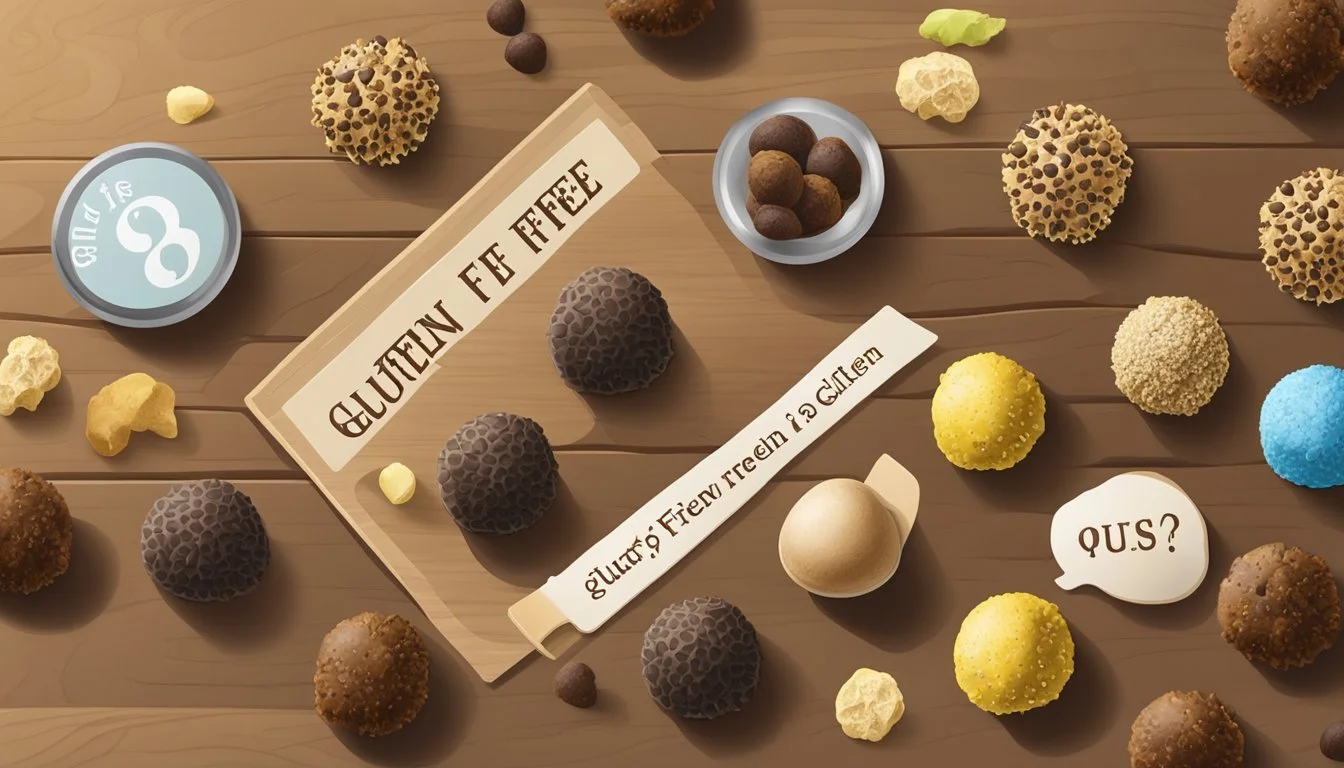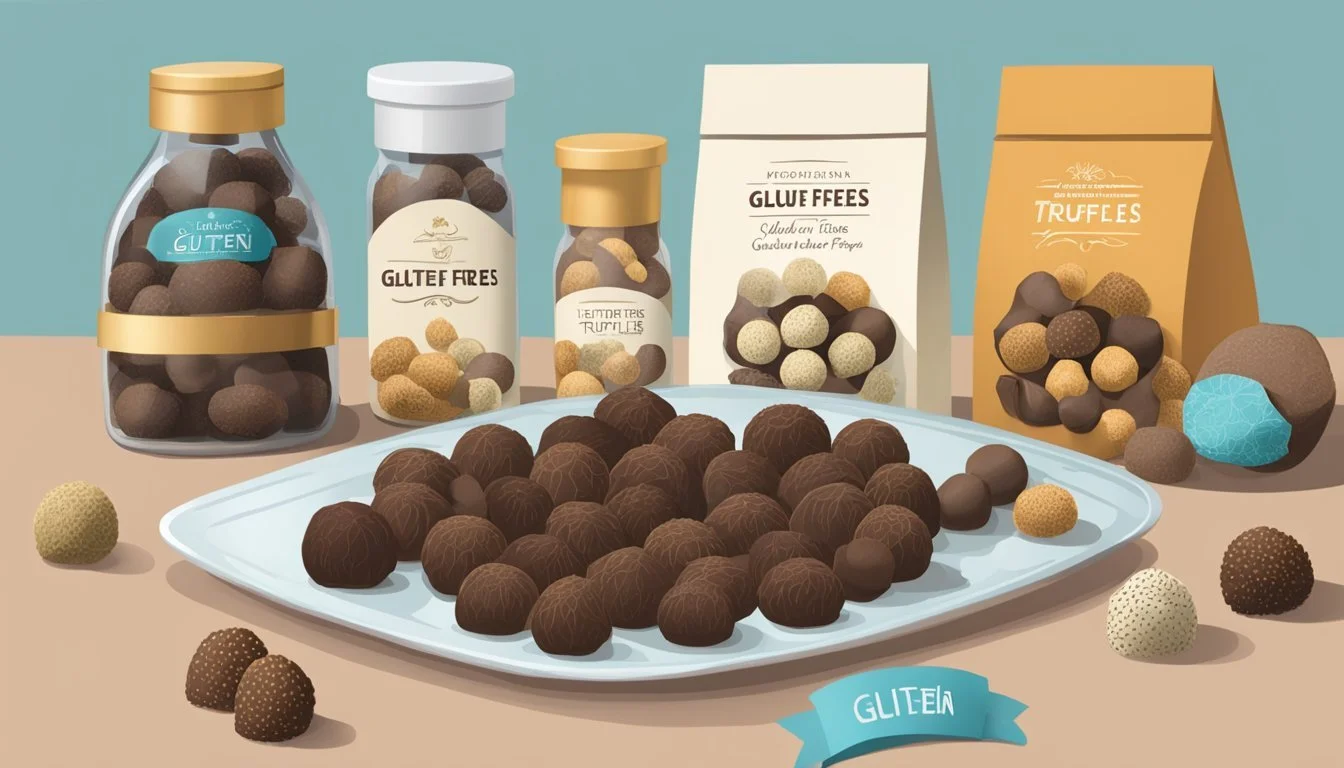Are Truffles Gluten-Free?
Unveiling the Facts for Celiac Concerns
Understanding whether truffles (What wine goes well with truffles?) are gluten-free is important for individuals with gluten sensitivities or celiac disease. Truffles, in both their chocolate (What wine goes well with chocolate?) and fungal forms, are naturally gluten-free. Chocolate truffles typically consist of a chocolate ganache center coated in chocolate, cocoa powder, or nuts. The main ingredients of this confectionery, such as chocolate, cream, and butter, do not contain gluten. However, when considering store-bought or restaurant-served truffles, consumers must be mindful of additional ingredients that may introduce gluten.
When exploring the culinary world of truffles, it is essential to distinguish between chocolate truffles and the edible fungi known as truffles. The latter are a type of mushroom renowned for their strong flavor and aroma. Like other mushrooms, these truffles are inherently gluten-free and safe for a gluten-free diet.
Caution is advised for individuals purchasing packaged truffles or truffle-flavored products. Cross-contamination can occur during manufacturing, and truffle-flavored items may contain gluten-containing ingredients. For those with gluten intolerance, it's recommended to review ingredient lists and, if available, to look for gluten-free certification or contact manufacturers directly to confirm the gluten status of particular truffle products.
Understanding Truffles
Truffles are a type of fungi, akin to mushrooms, that are revered in culinary circles for their distinctive, earthy flavor. They are known to be naturally gluten-free, rendering them a safe ingredient for those with celiac disease or gluten sensitivities. As a premium product, truffles are often used to enhance the flavor of various dishes, including those that fit into a gluten-free diet.
When it comes to chocolate truffles, these delectable treats are named after the fungi due to their similar shape and prized status. The basic ingredients in chocolate truffles typically include:
Chocolate: White or dark varieties may be used.
Cream: Adds a rich, creamy texture.
Butter: Sometimes used for additional richness.
The intrinsic ingredients of chocolate truffles do not contain gluten. However, it is crucial for consumers to be mindful of additional elements such as coatings or flavorings which could introduce gluten.
Truffle Quality and Safety:
Certified Gluten-Free: Look for this label to ensure safety.
Ingredients Check: Always review the ingredient list.
People with gluten sensitivities or celiac disease must exercise caution and choose products that guarantee a gluten-free experience. This can mean opting for truffles that are certified gluten-free to avoid cross-contamination risks.
In summary, both truffles and their chocolate namesakes can be enjoyed as part of a gluten-free diet, provided that they are carefully sourced and scrutinized for any additional gluten-containing ingredients.
Ingredients and Gluten Content
When considering whether truffles are gluten-free, it's essential to understand the ingredients typically used in their creation and how to identify gluten within those ingredients. For those with celiac disease or gluten sensitivities, ensuring safety is paramount, including being aware of certified gluten-free options.
Common Truffle Ingredients
The primary ingredients in most truffle recipes include chocolate, sugar, butter, and cream. Additional flavors like vanilla or nuts may also be incorporated. Genuine truffles, the fungi, are inherently gluten-free, as are the basic components of chocolate truffles.
Identifying Gluten in Ingredients
Gluten is a protein found in wheat, barley, and rye. When reviewing truffle ingredients, look for these grains or their derivatives on labels. Cross-contamination during manufacturing can also introduce gluten. Quality control measures are crucial in verifying that a product remains free from gluten contamination.
Gluten-Free Alternatives
In recipes where gluten-containing ingredients might typically be used, alternatives are available. Gluten-free flour can replace wheat flour, and natural flavorings should be chosen with care to avoid gluten-containing additives. Always check the labels for a certified gluten-free mark.
Safety for Celiac Disease Sufferers
Individuals with celiac disease must avoid gluten to prevent health complications. It’s advised to seek products with clear gluten-free labeling and consult with a healthcare professional for guidance on safe products and practices.
Certified Gluten-Free Products
Products that carry a certified gluten-free label have undergone testing to meet strict guidelines, ensuring they are safe for those with gluten sensitivities. Companies like Lindt often ensure their products, such as certain chocolate truffles, meet these standards to cater to diverse dietary needs.
Truffle Recipes and Preparation
Creating delightful gluten-free truffles requires a combination of careful selection of gluten-free ingredients and execution of precise techniques. This section provides insights on recipe adaptation, cooking methods, decoration, and baking principles tailored for gluten-free truffles.
Creating Gluten-Free Truffle Recipes
When adapting recipes to be gluten-free, one should ensure that all ingredients, including the chocolate and any flavorings or mix-ins, are free from gluten. Utilizing a food processor can facilitate the fine crushing of gluten-free cookies to use in recipes. For no-bake options, a mixture of ingredients like gluten-free cookie crumbs and cream cheese can be beaten together to form the base of the truffle.
Cooking Techniques and Tips
Various techniques can be applied in the preparation of truffles. Melting chocolate can be achieved gently using a double boiler to avoid burning, ensuring a smooth base for truffles. No-bake recipes call for chilling mixtures in the fridge, as with ganache-based truffles, before forming into balls. When working with a sticky mixture, chilling can help ease the rolling process and prevent sticking.
Truffle Rolling and Chilling:
Prep: Line a baking sheet with parchment paper.
Roll: Once chilled, use hands or a scoop to form balls.
Chill: Place shaped truffles back in the fridge to firm.
Decorating and Enhancing Flavor
After forming the truffles, they can be coated for added texture and flavor. Garnishes such as cocoa powder, ground nuts, chopped fruit, or sprinkles provide layers of taste and visual appeal. The truffles should be rolled in the desired coatings before being set aside to firm up.
Truffle Decor Options:
Cocoa Powder: Classic and simple
Nuts: For a crunchy exterior
Sprinkles or Fruit: For color and variety
Gluten-Free Baking Considerations
For recipes requiring baking, it's imperative to utilize gluten-free flour blends that mimic the properties of wheat flour. Cook times in an oven may need adjustments compared to traditional recipes. When baking, always use parchment paper on the baking sheet to prevent sticking and cross-contamination, especially in kitchens where gluten-containing products are also prepared.
Remember to meticulously review all ingredients within recipes to confirm their gluten-free status and avoid cross-contamination during preparation.
Storage and Serving of Truffles
Storing truffles correctly ensures they maintain their quality and flavor, while thoughtful serving enhances the overall experience of enjoying this sophisticated treat.
Proper Truffle Storage
Truffles, whether homemade or store-bought, need to be stored in an airtight container to preserve their freshness and prevent them from absorbing odors. In the fridge, truffles can be kept for up to two weeks when stored properly. For longer storage, they can be frozen for a few months; however, the texture might change slightly upon thawing. At room temperature, truffles should be kept in a cool, dark place, ideally in an airtight container, and consumed within a few days to prevent melting or spoilage.
Serving Suggestions and Presentation
When presenting truffles, they should be treated as a luxurious dessert or a special holiday treat. They are excellent as gifts and can be beautifully packaged in decorative boxes lined with parchment. Serve at room temperature to allow the flavors to shine. Truffles can be rolled in cocoa powder, nuts, or spices for an attractive finish and are perfect as a garnish on desserts. A diverse assortment offers guests a variety of flavors to enjoy, and when gifting, a mixed selection reflects thoughtfulness and attention to the recipient's palate.
Truffle Variations and Innovations
Truffles are renowned for their versatility and ability to adapt to a variety of occasions and dietary preferences. The innovation in truffle production has led to a broad spectrum of flavor profiles, catering to different seasons and dietary needs.
Seasonal and Holiday Truffles
Truffle makers often create special editions to celebrate the holidays, with Christmas gifts and holiday treats taking center stage during the winter season. Seasonal ingredients such as peppermint and pumpkin spice find their way into these confections, making them perfect for gifting. Unique to the holiday season, these truffles often feature festive decorations and packaging intended to delight recipients and add to the seasonal cheer.
Dietary Variation: Vegan and Nut-Free Options
Catering to dietary restrictions has become a priority. Vegan truffles are crafted using vegan semi-sweet or dark chocolate and plant-based creams. Nut-free options are ensuring inclusivity, with variations like sunbutter truffles providing a taste similar to peanut butter without the allergens. Both these offerings maintain the luxurious texture and richness expected from traditional truffles while ensuring that those with specific dietary needs can enjoy them.
Vegan Options:
Chocolate: Semi-sweet or dark chocolate, free from dairy.
Creams: Coconut or soy-based alternatives.
Sweeteners: Dates or maple syrup.
Nut-Free Alternatives:
Nut Butter Replacement: Sunflower seed butter, pumpkin seed butter.
Nut-Free Chocolate: Ensure cross-contamination is minimized by choosing certified nut-free brands.
Exploring Creative Truffle Flavors
Truffle artisans are constantly pushing the boundaries of flavor, incorporating a variety of fruit purees, exotic spices, and even savory elements to entice the palate. Use of white chocolate chips and semi-sweet chocolate allows for a broad range of flavor profiles, from the intense and earthy to the sweet and tangy, giving consumers a diverse tasting experience. These innovative flavors make truffles a year-round delight, with each new combination providing a fresh culinary adventure.
Purchasing and Brands
When seeking gluten-free truffles, consumers have a variety of brands to choose from, and these can be found in both online and physical retail outlets. Brands such as Lindt and Glutino offer options that cater to the gluten-free market, and retailers like Amazon and Wal-Mart make purchasing these products convenient.
Gluten-Free Truffle Brands
Several brands offer gluten-free chocolate truffles, ensuring that consumers with gluten intolerance or celiac disease can enjoy these treats safely. Here are some notable brands:
Lindt: Some Lindt truffles do not contain gluten ingredients, such as certain flavors of their LINDOR truffles. However, buyers should always check packaging for the most current information as recipes may change.
Glutino: Known for their commitment to gluten-free products, Glutino offers a variety of gluten-free confections.
Great Value: Wal-Mart's store brand, Great Value, also provides options for those looking for gluten-free chocolates, although customers should verify the gluten status on the packaging.
It is important for consumers to look for labels that say "certified gluten-free" if they need assurances due to health concerns.
Where to Find Gluten-Free Truffles
Gluten-free truffles are accessible from multiple outlets:
Online Retailers: Amazon features an array of gluten-free truffles from various brands, often with detailed product descriptions and customer reviews.
Supermarkets and Specialty Stores: Common supermarkets, as well as specialty food stores, may carry gluten-free truffle options.
Direct Brand Purchases: Consumers can also purchase directly from brand websites, which may provide more detailed product information and company-specific gluten-free certification details.
When purchasing gluten-free truffles, always read labels closely as ingredients can change and cross-contamination with gluten-containing products is possible in facilities that process multiple items.
Health and Nutrition
Truffles are not only esteemed for their unique flavor but also appreciated for being naturally gluten-free, suitable for individuals with celiac disease or gluten sensitivities. In this section, we will explore the nutritional aspects of truffles and the considerations for incorporating gluten-free truffle products into a diet.
Nutritional Profile of Truffles
Truffles are a type of fungi that grow underground, typically found near the roots of certain trees. They are low in calories but rich in nutrients, providing a good source of protein, fiber, and essential vitamins and minerals, such as vitamin C, phosphorus, sodium, calcium, magnesium, manganese, and iron. Truffles are notable for containing a high content of unsaturated fatty acids, which contribute to heart health. Here's a brief overview of their nutrient content:
Calories: Low
Protein: Good source
Fiber: Good source
Vitamins/Minerals: Vitamin C, phosphorus, etc.
Fats: High in unsaturated fatty acids
Diet Considerations with Gluten-Free Truffles
When incorporating truffles into a gluten-free diet, it is essential to ensure that all truffle products are indeed free of gluten-contaminants. While truffles themselves do not contain gluten, products derived from truffles, such as truffle-infused oils or truffle-flavored snacks, may not always be safe for those with celiac disease or gluten sensitivities unless they are certified gluten-free.
Ingredients commonly used in truffle dishes, like butter and cream, are naturally gluten-free, but always check the labels for possible gluten-containing additives. For those making truffle-based treats at home, such as chocolate truffles, pay attention to all components including the sugar, cream, and any additions like nuts which should also be confirmed gluten-free to avoid cross-contamination.
Individuals with celiac disease or gluten sensitivities should consult with a healthcare professional before making significant dietary changes to ensure that they are meeting their nutritional needs while adhering to a gluten-free diet.
Common Questions and Misconceptions
In the realm of gluten-free confections, truffles often come into question. Discerning which truffles are safe for individuals with celiac disease or gluten sensitivities is paramount, including understanding the risks of cross-contamination.
Addressing Gluten-Free Truffle FAQs
Are all truffles gluten-free?
Not all truffles are gluten-free. It's essential for consumers to check the ingredient list and manufacturing processes due to potential gluten sources or cross-contamination risks.Can individuals with celiac disease safely eat truffles? Individuals with celiac disease can eat truffles that are certified gluten-free. These truffles have been rigorously tested to ensure they don't contain gluten or are not subject to cross-contamination.
What does cross-contamination mean in the context of gluten-free truffles? Cross-contamination occurs when gluten-free foods come into contact with gluten-containing foods or surfaces, rendering them unsafe for individuals with celiac disease or gluten sensitivities.
How can consumers ensure the truffles they purchase are gluten-free?
Consumers should look for truffles labeled as 'gluten-free' and check for certification from reputable organizations. Additionally, researching the brand's commitment to gluten-free products is advisable.Is it enough to choose truffles that don’t list gluten-containing ingredients? No. Due to cross-contamination, it is not enough to simply avoid gluten-containing ingredients. Facilities that also process gluten could inadvertently contaminate the truffles.







